We’ve all fallen in love with that creamy, earthy sweetness of matcha milk tea – and now we’re sharing the secret to making this café-quality drink at home. This vibrant green beverage combines the ancient tradition of Japanese matcha with modern milk tea culture, creating a perfect balance of bitter and sweet that’s absolutely irresistible.
Making matcha milk tea isn’t just about mixing powder with milk. We’ll show you how to properly whisk matcha to avoid those dreaded lumps, select the right milk for optimal creaminess, and achieve that Instagram-worthy foam top that makes every sip memorable.
Whether you’re craving an afternoon pick-me-up or want to impress guests with your barista skills, this homemade version delivers all the flavor without the coffee shop price tag. Let’s transform your kitchen into a matcha paradise with this foolproof recipe that’s ready in just minutes.
Ingredients
Creating our perfect matcha milk tea requires carefully selected ingredients that balance quality with accessibility. We’ve organized these ingredients by their exact roles in achieving that signature creamy texture and vibrant matcha flavor.
For the Matcha Base
- 2 teaspoons high-quality matcha powder (ceremonial grade preferred)
- 2 tablespoons hot water (175°F to 185°F)
- 1 tablespoon granulated sugar or maple syrup
- 1/4 teaspoon vanilla extract (optional)
For the Milk Tea
- 1 cup whole milk (or oat milk for dairy-free option)
- 1/2 cup ice cubes
- 2 tablespoons heavy cream (for extra richness)
- 1 tablespoon simple syrup or honey (adjust to taste)
Optional Toppings and Sweeteners
- 2 tablespoons tapioca pearls (boba)
- 1 tablespoon brown sugar syrup
- Whipped cream for topping
- Additional matcha powder for dusting
- Coconut flakes
- Condensed milk (for extra sweetness)
Equipment Needed
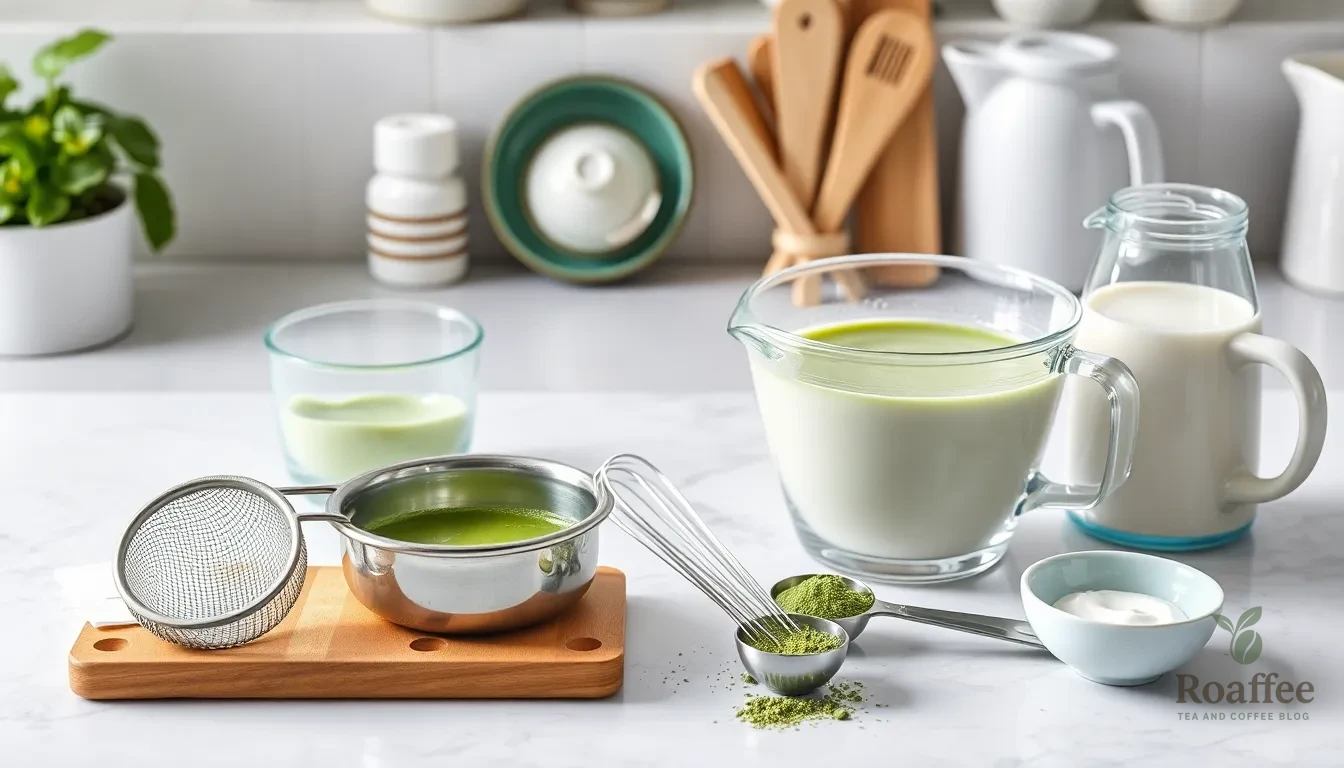
We recommend gathering the right tools before starting your matcha milk tea preparation. The proper equipment ensures smooth mixing and creates that perfect café-quality texture we’re aiming for.
Essential Equipment:
- Fine-mesh sieve – Removes clumps from matcha powder for silky smoothness
- Small whisk or bamboo chasen – Creates proper matcha paste without lumps
- Measuring spoons – Ensures accurate matcha and sweetener ratios
- Small mixing bowl – Provides space for whisking matcha paste
- Tall glass or serving cup – Accommodates ice and layered presentation
- Tablespoon for stirring – Combines all ingredients thoroughly
Optional but Helpful Equipment:
- Milk frother or French press – Creates professional foam texture
- Fine-mesh strainer – Removes any remaining matcha particles
- Small saucepan – Warms milk if you prefer hot matcha milk tea
- Ice cube tray – Ensures you have enough ice for chilling
Equipment Substitutions:
| Missing Tool | Alternative Option |
|---|---|
| Bamboo chasen | Small wire whisk or fork |
| Fine-mesh sieve | Coffee filter |
| Milk frother | Mason jar with tight lid |
| Measuring spoons | Standard kitchen spoons |
We find that having these tools ready streamlines the entire process. The key equipment pieces focus on achieving smooth matcha integration and proper texture. You can create excellent matcha milk tea with basic kitchen tools if specialized equipment isn’t available.
Instructions

We will guide you through each step to create smooth and creamy matcha milk tea with perfect balance. These instructions ensure your drink achieves the ideal texture and flavor every time.
Prep the Matcha Powder
We start by sifting 2 teaspoons of matcha powder through a fine-mesh sieve into a small mixing bowl. This step removes any lumps and creates a smooth base for whisking.
Add 2 tablespoons of hot water (around 175°F) to the sifted matcha powder. Using a bamboo chasen or small whisk, we create a figure-8 motion to whisk the mixture vigorously for 30-45 seconds. The matcha paste should become smooth and slightly frothy with no visible clumps remaining.
Stir in 1 tablespoon of granulated sugar or maple syrup into the matcha paste. Mix until the sweetener dissolves completely. Add 1/4 teaspoon of vanilla extract if using for extra depth of flavor.
Heat the Milk
We warm 1 cup of whole milk (or oat milk) in a small saucepan over medium-low heat. Heat the milk to approximately 150°F without letting it boil. Steam should rise gently from the surface.
Remove the milk from heat once it reaches the proper temperature. Pour 2 tablespoons of heavy cream into the warm milk and stir gently to combine. This creates the rich and creamy base our matcha tea requires.
Combine Matcha and Milk
We slowly pour the warm milk mixture into the matcha paste while whisking continuously. This prevents the matcha from clumping and ensures even distribution throughout the drink.
Whisk the combined mixture for another 15-20 seconds until the color becomes uniform and the texture appears smooth. The drink should have a beautiful jade green color with no streaks or separation visible.
Add Sweetener
We taste the matcha milk tea and adjust sweetness as needed. Add 1 tablespoon of simple syrup or honey gradually while stirring. Different matcha powders vary in bitterness so we recommend starting with less sweetener and building up.
Stir the sweetener until it dissolves completely. The final drink should balance the earthy matcha flavor with just enough sweetness to enhance rather than overpower the tea.
Serve and Garnish
We fill a tall glass with 1/2 cup of ice cubes for a refreshing cold drink. Pour the matcha milk tea over the ice slowly to maintain the beautiful color gradient.
Top with a light dusting of matcha powder using a fine-mesh sieve for an elegant presentation. Add whipped cream or your preferred toppings like tapioca pearls if desired. Serve immediately while the drink maintains its optimal temperature and texture.
Directions for Hot Matcha Milk Tea
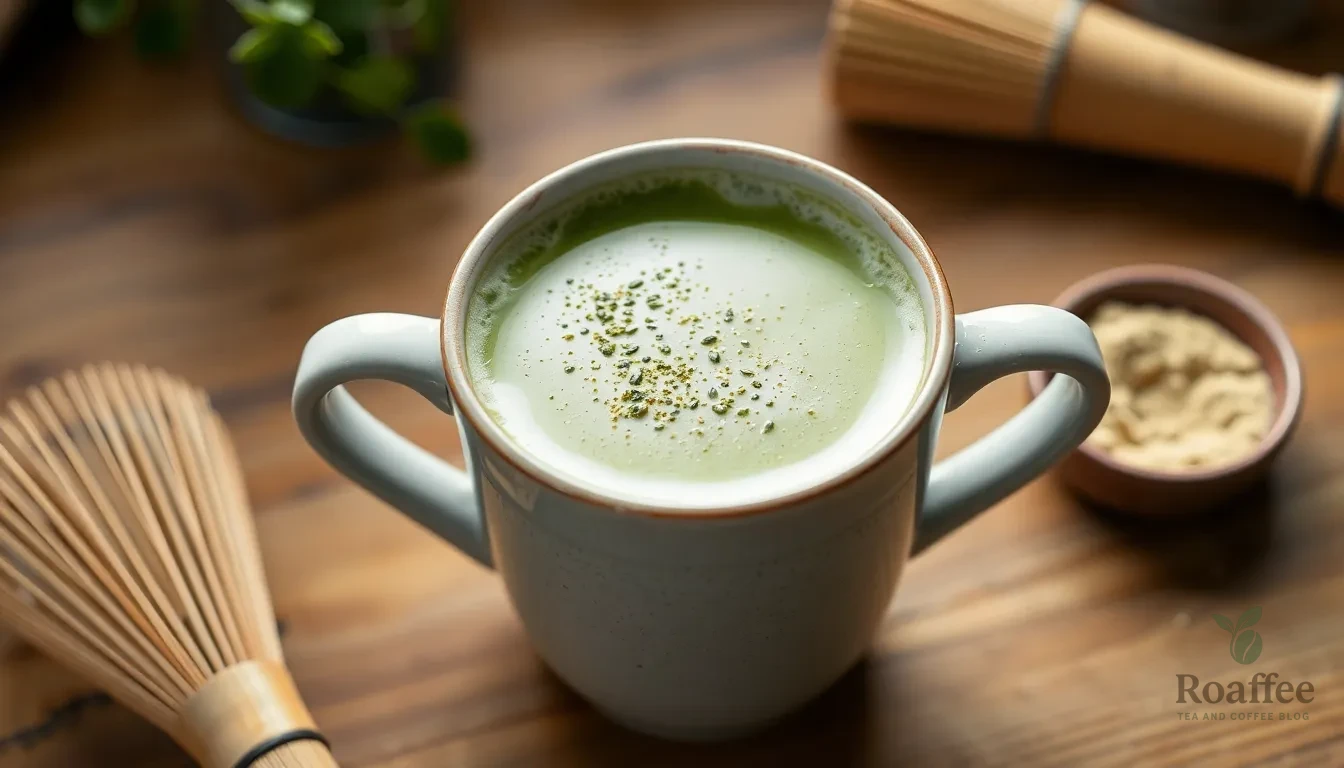
Step 1: Sift the Matcha Powder
We begin by sifting 2 teaspoons of high-quality matcha powder through a fine-mesh sieve into a small mixing bowl. This crucial step eliminates lumps and ensures our matcha dissolves completely without clumps.
Step 2: Create the Matcha Base
Add 2 tablespoons of hot water (not boiling) to the sifted matcha powder. Using a small whisk or bamboo chasen we vigorously whisk the mixture in a W-shaped motion for 30-45 seconds until it becomes frothy and smooth. The paste should have a vibrant green color and creamy consistency.
Step 3: Add Sweetener
Incorporate 1 tablespoon of granulated sugar or maple syrup into the matcha base while it’s still warm. Whisk thoroughly until the sweetener completely dissolves. If using vanilla extract add 1/4 teaspoon at this stage for enhanced flavor depth.
Step 4: Heat the Milk
Pour 1 cup of whole milk (or your preferred milk alternative) into a small saucepan over medium-low heat. Warm the milk until it reaches approximately 150°F to 160°F. Steam should rise from the surface but avoid bringing it to a boil as this can create an unpleasant skin on top.
Step 5: Combine Milk with Matcha
Slowly pour the heated milk into the matcha base while continuously whisking. This gradual incorporation prevents the matcha from clumping and creates a silky smooth texture. Add 2 tablespoons of heavy cream for extra richness and continue whisking until fully combined.
Step 6: Adjust Sweetness and Serve
Taste your hot matcha milk tea and adjust sweetness with 1 tablespoon of simple syrup or honey if desired. Pour the finished drink into a warmed cup or mug. Garnish with a light dusting of matcha powder or whipped cream for an elegant presentation. Serve immediately while hot for the best flavor experience.
Directions for Iced Matcha Milk Tea

Step 1: Sift the Matcha Powder
We begin by sifting 2 teaspoons of matcha powder through a fine-mesh sieve into a small mixing bowl. This essential step removes any lumps and ensures our matcha base will be perfectly smooth.
Step 2: Create the Matcha Base
Add 2 tablespoons of hot water (around 175°F) to the sifted matcha powder. We whisk vigorously in a zigzag motion using a bamboo chasen or small whisk until the mixture becomes frothy and paste-like. The consistency should be smooth without any visible powder clumps.
Step 3: Sweeten the Base
While the matcha base is still warm, we stir in 1 tablespoon of granulated sugar or maple syrup. Mix thoroughly until the sweetener dissolves completely. If using vanilla extract, we add 1/4 teaspoon now for enhanced flavor depth.
Step 4: Prepare the Milk Mixture
Pour 1 cup of whole milk into a separate container and add 2 tablespoons of heavy cream. We can warm this mixture slightly in the microwave for 30 seconds to help it blend more smoothly with the matcha base.
Step 5: Combine Matcha and Milk
Slowly pour the milk mixture into the matcha base while whisking continuously. This gradual incorporation prevents the matcha from clumping and creates a silky texture throughout the drink.
Step 6: Chill and Serve
Fill a tall glass with 1/2 cup of ice cubes. We pour the matcha milk tea over the ice and stir gently with a tablespoon. Taste and adjust sweetness by adding 1 tablespoon of simple syrup or honey if desired. Serve immediately while the drink is refreshingly cold.
Step 7: Add Optional Garnishes
For an elevated presentation, we can dust the top with extra matcha powder, add a dollop of whipped cream, or include tapioca pearls for texture. These finishing touches transform our homemade creation into a café-quality beverage.
Make-Ahead Instructions
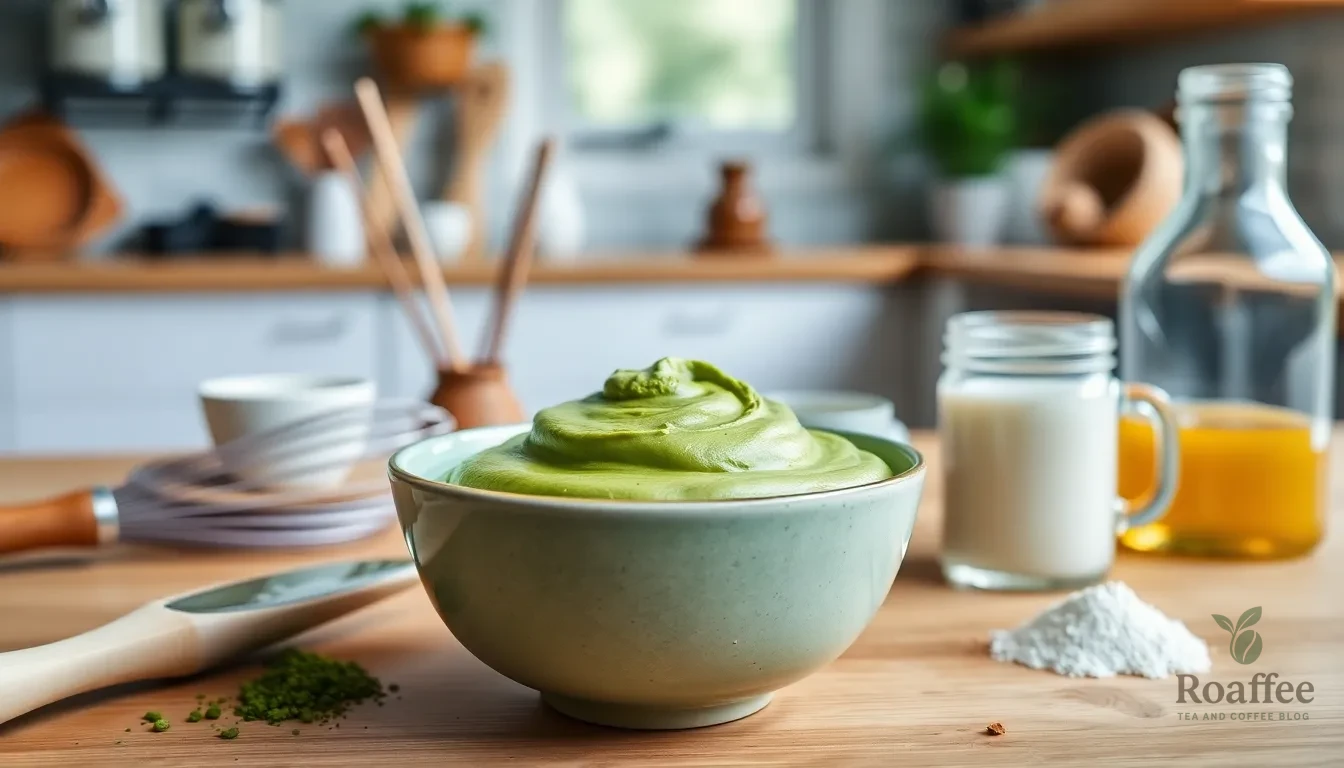
We can streamline our matcha milk tea preparation by completing several components in advance. Our make-ahead approach saves precious time during busy mornings or when entertaining guests.
Matcha Base Preparation
Sift the matcha powder and store it in an airtight container for up to one week. We recommend preparing the matcha paste by whisking 2 teaspoons of sifted matcha with 2 tablespoons of hot water until frothy. This concentrated mixture keeps well in the refrigerator for 2-3 days when stored in a sealed container. Simply whisk the chilled paste vigorously before using to restore its smooth consistency.
Sweetener Answers
Simple syrup can be made in batches and stored in the refrigerator for up to one month. We prepare ours by combining equal parts sugar and water then heating until dissolved. Brown sugar syrup follows the same method but adds deeper molasses notes to our matcha drinks. Both sweeteners blend more easily when added to warm matcha paste rather than cold beverages.
Milk Mixture Storage
Our milk and cream blend can be prepared and refrigerated for up to 3 days. We combine 1 cup of whole milk with 2 tablespoons of heavy cream in a clean container. This pre-mixed base eliminates measuring steps and ensures consistent creaminess in every serving. Shake the container well before each use as separation naturally occurs during storage.
Assembly Timeline
For best results we assemble our matcha milk tea within 30 minutes of serving. The prepared matcha base whisks easily into our chilled milk mixture creating that signature smooth texture. Ice should be added just before serving to prevent dilution. Fresh garnishes like whipped cream or extra matcha powder perform best when applied immediately before presentation.
Batch Preparation Tips
We can multiply our recipe by four to create pitcher-sized portions for parties. Store the combined matcha and milk mixture in the refrigerator for up to 24 hours. Individual servings pour easily over ice and maintain their vibrant green color and creamy consistency throughout the day.
Storage Tips
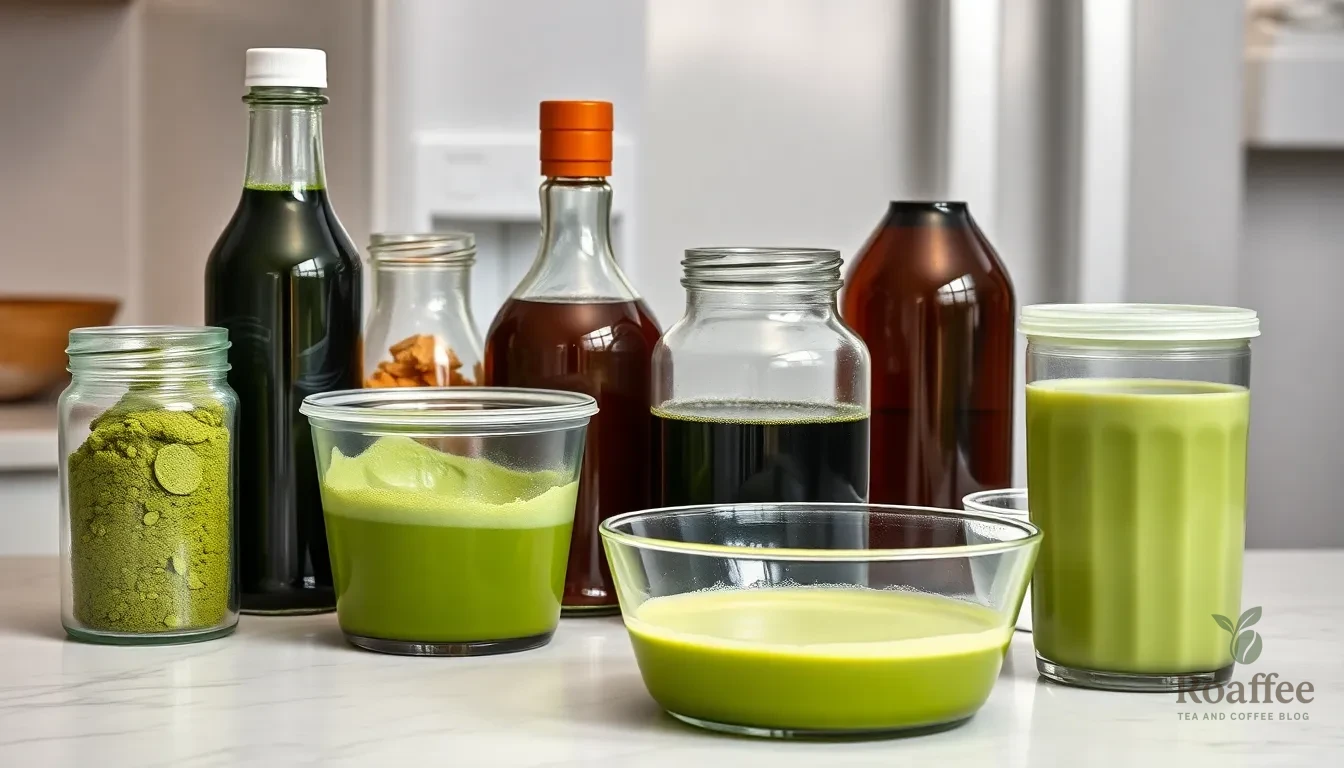
We store prepared matcha milk tea in the refrigerator for up to 2 days in an airtight container to maintain optimal freshness. The vibrant green color may slightly fade over time but the flavor remains delicious when properly stored.
Matcha base paste keeps well in the refrigerator for 3-4 days when stored in a sealed container. We always cover the surface with plastic wrap before sealing to prevent oxidation and color loss.
Dry matcha powder maintains its quality for 6-12 months when stored in an airtight container away from light and moisture. Room temperature storage works well for unopened packages while opened matcha should be refrigerated.
Simple syrup and brown sugar syrup stay fresh for up to 2 weeks when refrigerated in glass jars or bottles. We label each container with the preparation date to track freshness.
The milk and cream mixture can be prepared ahead and stored in the refrigerator for 3 days maximum. We recommend giving it a gentle stir before using as separation may occur.
Assembled matcha milk tea should be consumed within 4 hours for the best texture and flavor. Ice will dilute the drink over time so we suggest storing components separately when possible.
We freeze leftover matcha paste in ice cube trays for up to 1 month. Each cube creates a single serving when combined with fresh milk and sweetener.
Opened matcha powder should never be stored at room temperature as heat and humidity will quickly degrade its quality. We keep it in the refrigerator door where temperature remains consistent.
Glass containers work better than plastic for storing matcha components as they prevent odor absorption and maintain flavor purity. We avoid metal containers that can react with acidic ingredients.
Variations and Customizations
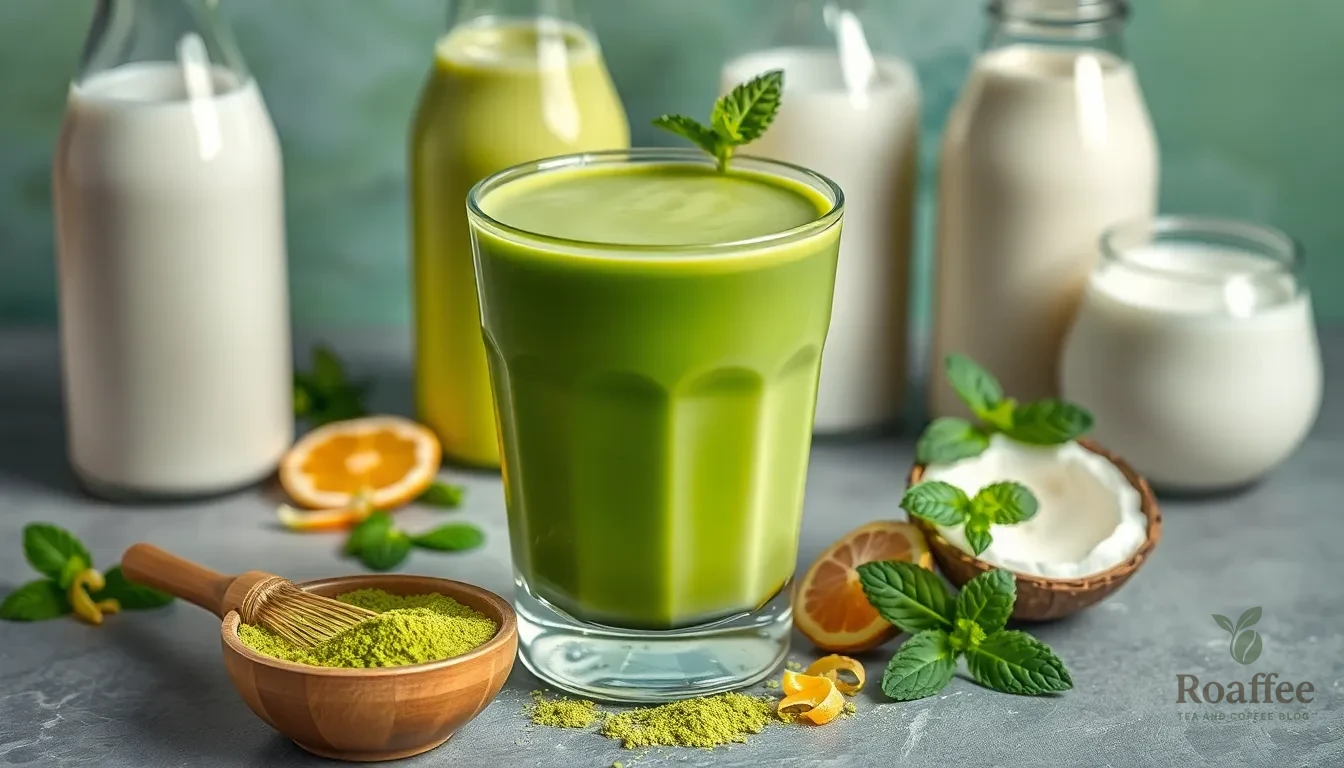
We love experimenting with different elements to create unique matcha milk tea experiences. These customizations allow us to adjust the flavor profile and texture to match personal preferences or dietary needs.
Different Milk Options
Dairy Alternatives offer creamy textures without compromising the matcha flavor. Oat milk provides the closest texture to whole milk with natural sweetness that complements matcha’s earthy notes. Coconut milk adds tropical richness and creates a slightly thicker consistency perfect for iced versions.
Almond milk delivers a lighter option with subtle nutty undertones that enhance the matcha’s complexity. We recommend using unsweetened varieties to maintain control over sweetness levels. Cashew milk blends seamlessly with matcha powder and creates an exceptionally smooth texture.
Soy milk works well for those seeking protein content while maintaining creaminess. Choose organic varieties for the cleanest flavor profile. Rice milk offers the lightest option but requires additional cream or thickeners to achieve proper consistency.
Milk Fat Content significantly impacts the final texture and mouthfeel:
| Milk Type | Fat Content | Texture Result | Best For |
|---|---|---|---|
| Whole Milk | 3.25% | Rich and creamy | Traditional preparation |
| 2% Milk | 2% | Balanced creaminess | Everyday drinking |
| 1% Milk | 1% | Light texture | Health-conscious options |
| Skim Milk | 0% | Thin consistency | Requires cream addition |
Sweetener Alternatives
Natural Sweeteners enhance the matcha flavor without overpowering its delicate taste. Maple syrup adds depth with caramel notes that complement matcha’s earthiness. We use grade A maple syrup for the cleanest flavor profile and dissolve it completely in the warm matcha base.
Honey provides floral complexity that pairs beautifully with ceremonial grade matcha. Clover honey offers mild sweetness while wildflower honey adds more complex flavor notes. Raw honey maintains beneficial enzymes but requires thorough mixing to prevent crystallization.
Brown Sugar Syrup creates rich molasses undertones that transform basic matcha milk tea into a dessert-like experience. We prepare this by combining equal parts brown sugar and water then simmering until dissolved. This syrup stores well in the refrigerator for two weeks.
Sugar Substitutes accommodate various dietary requirements:
| Sweetener | Conversion Ratio | Flavor Profile | Special Notes |
|---|---|---|---|
| Stevia | 1/8 tsp per 1 tbsp sugar | Clean sweetness | Mix thoroughly to prevent aftertaste |
| Monk Fruit | 1/3 tsp per 1 tbsp sugar | Neutral sweetness | Dissolves easily in warm liquids |
| Agave Nectar | 3/4 amount of sugar | Mild caramel notes | Adds slight thickness |
| Coconut Sugar | 1:1 ratio | Subtle coconut flavor | Requires longer mixing time |
Flavor Additions
Vanilla Extract elevates the matcha experience with warm aromatic notes. We add 1/4 teaspoon of pure vanilla extract to the matcha base for subtle enhancement. Madagascar vanilla provides the most complex flavor profile while Mexican vanilla offers spicier undertones.
Coconut Extract creates tropical variations that pair exceptionally well with coconut milk. Use 1/8 teaspoon per serving to avoid overwhelming the matcha flavor. Toasted coconut flakes make excellent garnishes for enhanced texture and visual appeal.
Citrus Zest brightens the earthy matcha with fresh acidic notes. Lemon zest adds classic brightness while lime zest provides more intense citrus flavor. We recommend using organic citrus and adding zest to the matcha base rather than the finished drink.
Spice Blends transform basic matcha milk tea into warming beverages. Cinnamon powder adds comfort spice qualities while cardamom provides exotic aromatic complexity. Ginger powder creates warming sensations that complement matcha’s natural earthiness.
| Season | Flavor Addition | Amount per Serving | Preparation Method |
|---|---|---|---|
| Fall | Pumpkin Spice | 1/4 tsp | Mix into matcha base |
| Winter | Chai Spice Blend | 1/4 tsp | Steep in warm milk |
| Spring | Rose Water | 3-4 drops | Add to finished drink |
| Summer | Mint Extract | 1/8 tsp | Combine with matcha paste |
Troubleshooting Common Issues

Creating the perfect matcha milk tea requires understanding common problems that can arise during preparation. We encounter these issues frequently when making this delicate beverage at home.
Bitter or Astringent Taste
Water temperature plays a crucial role in matcha flavor development. We recommend using water between 160-175°F rather than boiling water which can make matcha taste bitter and harsh. When water is too hot it breaks down the delicate amino acids that provide matcha’s natural sweetness.
Matcha quality significantly impacts the final taste. Lower grade matcha powder often contains more tannins that create astringent flavors. We suggest investing in ceremonial grade or culinary grade matcha from reputable suppliers to avoid this issue.
Over-whisking can also contribute to bitterness. We whisk just until the matcha becomes frothy and well-incorporated rather than continuing for extended periods.
Lumpy or Grainy Texture
Sifting remains the most effective method for preventing lumps in matcha milk tea. We always pass matcha powder through a fine-mesh sieve before adding any liquid. This simple step eliminates clumps that form during storage.
Gradual liquid incorporation prevents grain formation. We add hot water slowly while whisking continuously to create a smooth paste before introducing the milk mixture. Adding all liquids at once can create stubborn lumps that resist dissolving.
Room temperature matcha powder integrates more easily than cold powder. We store our matcha at room temperature and allow it to warm slightly before preparation if it has been refrigerated.
Weak Matcha Flavor
Insufficient matcha powder creates a pale drink lacking the characteristic earthy flavor. We use 2 teaspoons of matcha powder per serving to ensure robust taste. Adding more milk without increasing matcha content dilutes the flavor profile.
Stale matcha powder loses potency over time. We replace matcha powder every 6-12 months and store it in an airtight container away from light and moisture. Fresh matcha should have a vibrant green color and grassy aroma.
Inadequate whisking prevents proper matcha extraction. We whisk vigorously for 30-60 seconds to fully activate the matcha powder and release its flavor compounds.
Separation Issues
Temperature differences between matcha paste and milk cause separation. We warm the milk slightly before combining it with the matcha base to ensure smooth integration. Cold milk added to hot matcha creates temperature shock that leads to separation.
Insufficient emulsification results in layered appearance. We continue whisking while slowly pouring the milk mixture into the matcha paste. This gradual combination creates a homogeneous blend.
Heavy cream helps stabilize the mixture and prevents separation. We add 2 tablespoons of heavy cream to create a richer consistency that maintains its smooth texture longer.
Foam Problems
Over-frothing milk creates dense foam that masks matcha flavor. We froth milk until it reaches a creamy consistency rather than stiff peaks. Light foam integration allows matcha taste to shine through.
Milk temperature affects foam stability. We heat milk to 140-150°F for optimal foam formation. Milk that is too hot or too cold fails to create lasting foam structure.
Non-dairy milk alternatives may not foam as readily as dairy milk. We add a small amount of coconut cream or use oat milk which froths better than almond or soy milk alternatives.
Color Fading
Exposure to light causes matcha’s vibrant green color to fade quickly. We serve matcha milk tea immediately after preparation and store any leftover portions in opaque containers.
Oxidation dulls matcha color over time. We minimize air exposure by covering drinks and consuming them within 4 hours of preparation for optimal visual appeal.
pH levels in some milk alternatives can affect matcha color. We test different milk options to find those that maintain the best color stability for our preferred presentation.
Conclusion
Now you’re equipped with everything you need to create café-quality matcha milk tea at home. We’ve covered the essential techniques from whisking the perfect matcha base to achieving that creamy foam top that makes each sip special.
The beauty of homemade matcha milk tea lies in its flexibility. You can adjust sweetness levels experiment with different milk alternatives and even prepare components ahead of time for busy mornings.
Remember that practice makes perfect when it comes to whisking matcha. Don’t get discouraged if your first attempt isn’t flawless – even experienced baristas needed time to master their technique.
With these methods stored in your recipe collection you’ll save money while enjoying this beloved beverage whenever the craving strikes. Your friends and family will be impressed by your newfound matcha skills.
Frequently Asked Questions
What is matcha milk tea?
Matcha milk tea is a creamy beverage that combines traditional Japanese matcha powder with milk and sweeteners. It blends the earthy, slightly bitter flavor of matcha with the smoothness of milk, creating a balanced drink with a vibrant green color and rich, frothy texture.
What ingredients do I need to make matcha milk tea?
You’ll need 2 teaspoons of high-quality matcha powder, 2 tablespoons of hot water, 1 tablespoon of sugar or maple syrup, 1 cup of whole milk, 1/2 cup of ice, and optionally 2 tablespoons of heavy cream and vanilla extract for extra richness.
What equipment is essential for making matcha milk tea?
Essential tools include a fine-mesh sieve, small whisk or bamboo chasen, measuring spoons, small mixing bowl, tall glass, and tablespoon for stirring. Optional equipment like a milk frother can enhance foam texture, but basic kitchen items work perfectly fine.
How do I prevent lumps in my matcha milk tea?
Always sift your matcha powder through a fine-mesh sieve before mixing. This removes any clumps and ensures a smooth consistency. Gradually whisk the matcha with hot water until frothy, then slowly incorporate the milk mixture while whisking continuously.
Can I make matcha milk tea ahead of time?
Yes, you can prepare components in advance. The matcha base paste can be refrigerated for 2-3 days, and the milk-cream mixture can be stored for up to 3 days. However, assemble the final drink within 30 minutes of serving for best results.
How should I store leftover matcha milk tea?
Store prepared matcha milk tea in an airtight container in the refrigerator for up to 2 days. The assembled drink should be consumed within 4 hours for optimal texture and flavor. Use glass containers to prevent odor absorption and maintain flavor purity.
What milk alternatives work best for matcha milk tea?
Oat milk provides the creamiest texture similar to dairy milk. Coconut milk adds tropical flavor, almond milk offers a lighter consistency, and soy milk creates good foam. Each alternative brings unique flavors and textures to complement the matcha.
Why does my matcha milk tea taste bitter?
Bitterness usually results from using water that’s too hot (over 175°F) or low-quality matcha powder. Use water between 160-175°F and invest in ceremonial-grade matcha. Adjust sweetness with honey, maple syrup, or simple syrup to balance the earthy flavors.
How can I achieve better foam in my matcha milk tea?
Whisk the matcha vigorously with hot water until frothy before adding milk. Use a milk frother or French press for extra foam. Warming the milk slightly helps create better texture, and adding heavy cream enhances the foam’s stability and richness.
What’s the best water temperature for making matcha milk tea?
Use water heated to 160-175°F (70-80°C). Water that’s too hot will make the matcha bitter, while water that’s too cool won’t properly dissolve the powder. Let boiling water cool for 2-3 minutes before whisking with matcha powder.















